As summer waves goodbye in North Carolina, the arrival of fall brings a burst of color that brightens up our gardens and yards. But while you may be familiar with the beautiful leaves changing color, you might be surprised to know that gorgeous fall-blooming flowers may pop up all over the state of North Carolina as well.
In this article, we will take you through the gardens of North Carolina and introduce you to the most colorful fall-blooming flowers that add charm and brightness to the season.
1. Golden Crownbeard (Verbesina encelioides)
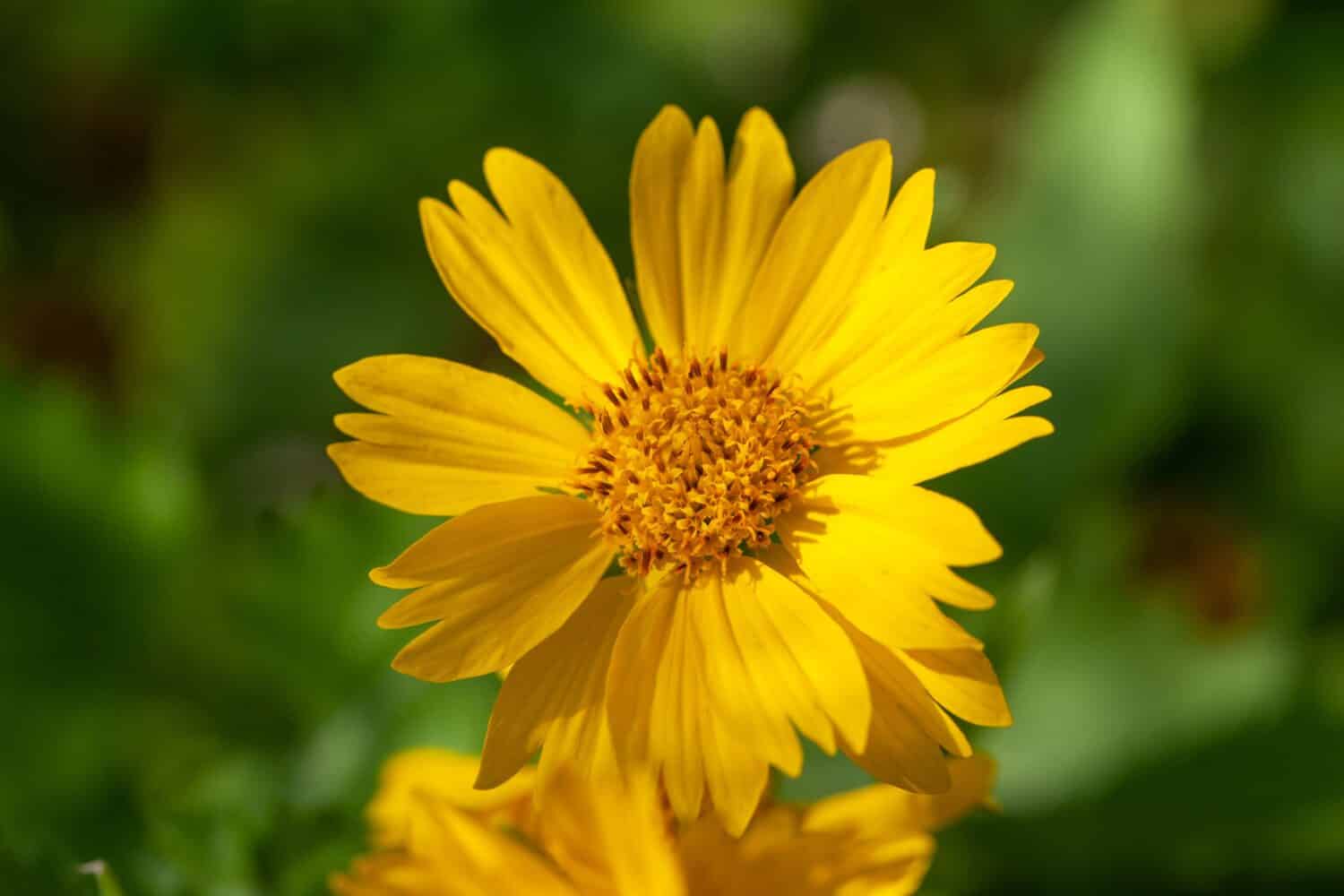
One of the best fall-blooming flowers in North Carolina is the golden crownbeard.
©ChWeiss/Shutterstock.com
The golden crownbeard emerges as a top contender among the first flowers to grace North Carolina’s landscapes during the fall months. This rapid-growing annual showcases a display of yellow blossoms, measuring up to 2 inches in diameter, perched on rigid, branched stems with silvery-green, toothy, almost triangular leaves, which alternate or appear opposite each other.
From spring through fall, each flower mesmerizes with its 8 to 15 radiant yellow petals that are notched at the tips, surrounding a central disk bustling with 80 to 150 tiny yellow tubes. This flower, native to the US, tends to develop in disturbed soils, offering a spectacular view throughout an extended period. It also attracts butterflies, bees, and moths!
The golden crownbeard can achieve a height between 2 and 5 feet, and under favorable conditions, it reproduces freely through self-seeding.
Growing Tips
- It’s best to grow this plant under direct sunlight, with soil that drains well.
- Adapts well to either nutrient-rich or nutrient-poor soils.
- Exhibits resistance to drought conditions.
2. New York Ironweed (Vernonia noveboracensis)
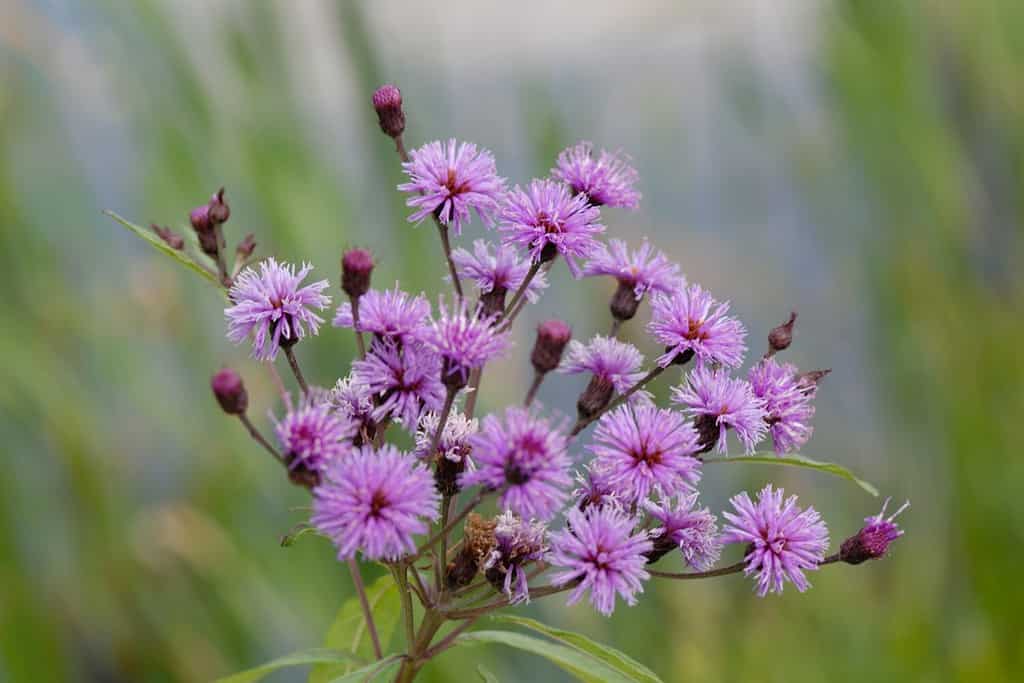
The New York ironweed is another colorful fall-blooming flower perfect for North Carolina gardens.
©Walter Erhardt/Shutterstock.com
Native to North Carolina, the New York ironweed is a splendid garden choice due to its robust nature. This tall, perennial plant forms clusters and shows off loosely branched bunches of small, purple flowers with delicate petals from late summer to early fall. Each bloom could host anywhere from 30 to 50 individual flowers.
A magnet for butterflies, this plant features rich green, lance-shaped leaves on rigid, upright stems. As seasons change, these give rise to fluffy, rusty clusters of seeds that become a feast for birds. Given its tall and slender structure, it’s an excellent fit for the back of flower beds or narrower spaces, thriving splendidly in native meadow gardens.
It typically reaches a height of 4 to 6 feet and spreads about 3 to 4 feet wide.
Growing Tips
- Prefers direct sunlight and can adapt to average, moderately moist, and wet soil types.
- Thrives in various soil conditions, including clay, but prefers rich, moist, and slightly acidic environments.
3. American Blue Vervain (Verbena hastata)

A striking perennial, the American blue vervain attracts pollinators like bees, butterflies, and birds.
©Danny Hummel/Shutterstock.com
The American blue vervain is a striking, tall perennial that forms upright clumps, showcasing slender spikes adorned with tiny lavender-purple flowers. These flowers occupy the high-reaching, branched stems, providing a beautiful display from the start of summer through to fall. The flowers unfurl gradually from the bottom up.
These plants are a hotspot for vital pollinators like bumblebees, and they are also known to draw butterflies and birds as well, adding to their charm. The green, lance-shaped leaves with sharp edges offer a lush backdrop for the flowers, making it a charming addition to wildlife gardens, borders, or areas near streams and ponds.
This plant can grow between 2 and 5 feet in height and expands 1 to 3 feet in width. It has the potential to self-seed, creating a continuous presence in your garden.
Growing Tips
- Ideally planted in spots receiving full sunlight, in soil that is moist with good drainage.
- Has the ability to withstand periods of drought.
4. Hairy Aster (Symphyotrichum pilosum)
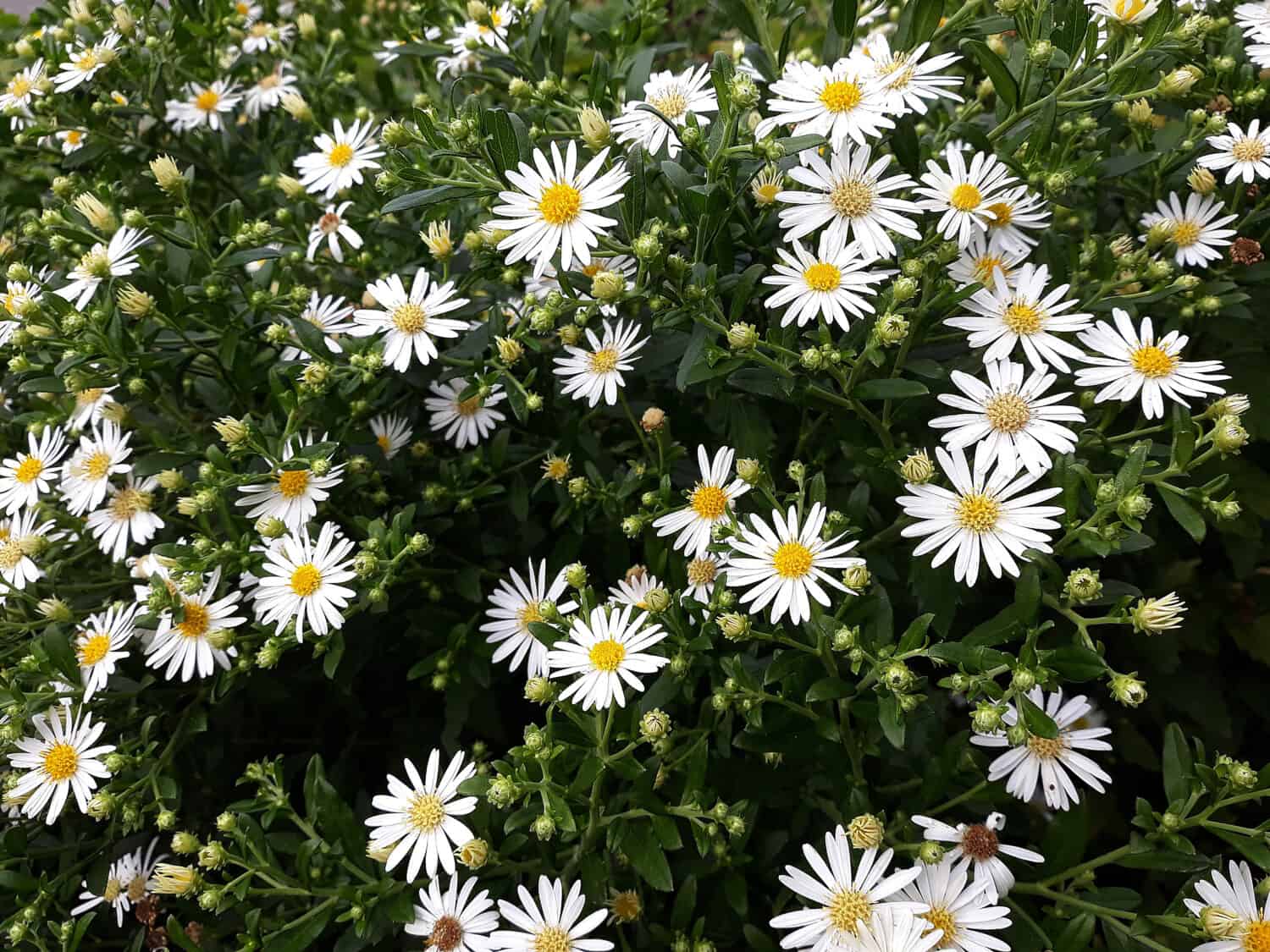
Another perennial that is a lovely fall-blooming flower in North Carolina is the hairy aster.
©Gabriela Beres/Shutterstock.com
The hairy aster is a sturdy perennial plant characterized by its branched stems covered in clusters of small, star-shaped white flowers that appear in the latter part of summer and continue into the fall. These blossoms, originating from the topmost parts of the stems and the upper sections where leaves join the stems, boast 15 to 35 delicate white rays that encircle a central disc filled with soft yellow florets.
Native to the diverse habitats of North America, like upland prairies and open woodlands, the hairy aster is an easy-to-grow flowering plant. However, it tends to grow quite profusely, often like a weed, especially in the eastern regions of the U.S.
This plant adopts a bushy growth pattern, achieving a height and width ranging from 2 to 4 feet.
Growing Tips
- Prefers a location with abundant sunlight, with sandy, rocky, or well-draining dry to moderately moist soils.
- Benefits from a bit of shade during the hot afternoon hours in regions experiencing warm summers.
5. Nodding Lady’s Tresses (Spiranthes cernua)

Boasting tiny white flowers, the nodding lady’s tresses plant grows up to 18 inches tall.
©Brian Woolman/Shutterstock.com
A nodding lady’s tresses plant in a fall-blooming garden is a remarkable sight in North Carolina, with its cluster-forming terrestrial orchid features. This plant showcases a tall, thin stem that holds tiny white flowers organized in a spiral pattern. The flowers gently hang downwards, which is reflected in the plant’s name. These fragrant flowers grace gardens from the end of summer through late fall, often persisting until the initial frost.
Arranged in 2 to 4 coiling rows, they create a thick spike approximately 6 inches long. These flowers are a nectar source for both long and short-tongued bees that visit occasionally. This plant, which hails from eastern North America, is known for its adaptability and vitality, making it one of the simplest hardy orchids to grow, especially in fall bog gardens.
The plant reaches a height of 10 to 18 inches and spreads about 10 to 12 inches wide.
Growing Tips
- Flourishes optimally in areas with full sun to partial shade.
- Plant in soils that are moist, acidic, and have a boggy texture.
6. Pitcher Sage (Salvia azurea)

With its gorgeous sky-blue blossoms, the pitcher sage blooms from summer till the first frost.
©iStock.com/Nahhan
The pitcher sage is a bushy perennial plant that forms clumps and showcases splendid rods adorned with large, two-lipped, sky-blue blooms from the middle of summer until the frost arrives. These graceful floral rods emerge from strong stems that have lengthy, slender, gray-green leaves.
Initially growing in an upright manner, this sage starts to spread out, mingling with surrounding plants as it begins to flower around midsummer. It serves as a stunning element in gardens during the late season, harmoniously integrating with other plants in garden beds and borders.
This plant achieves a height between 3 and 5 feet and spreads about 2 to 4 feet wide.
Growing Tips
- Best grown in areas receiving full sunlight, planted in soil ranging from dry to medium moisture levels, with efficient drainage.
- Can endure drought conditions and adapt well to dry soils.
7. Shrubby Cinquefoil (Potentilla fruticosa)
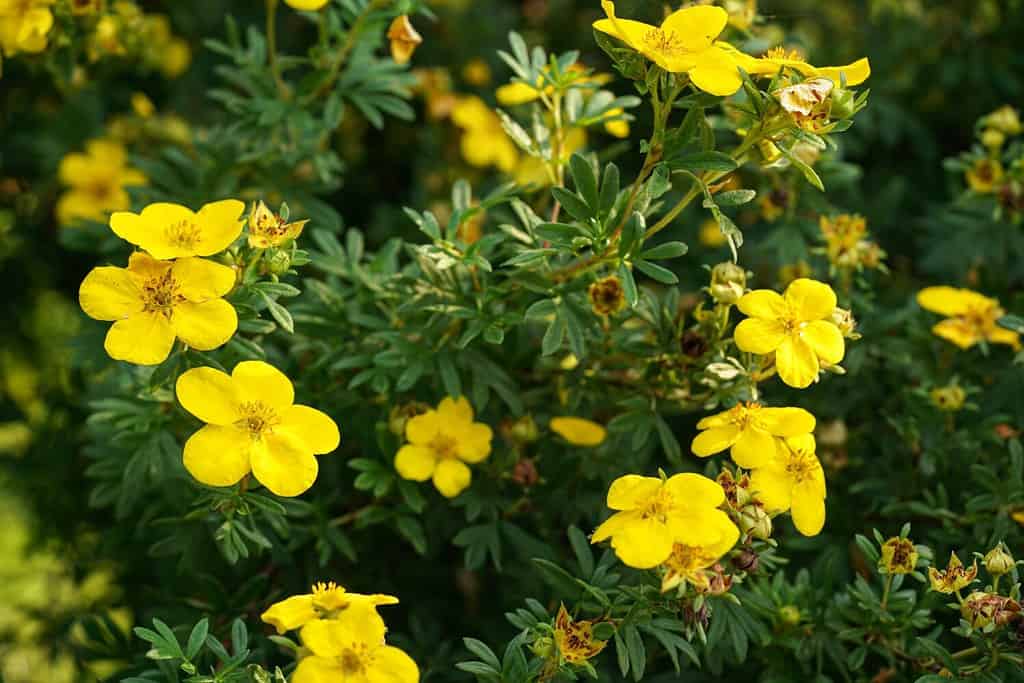
The flowers of the shrubby cinquefoil grow up to 1.5 inches wide.
©Lubo Ivanko/Shutterstock.com
The shrubby cinquefoil is a dense, compact, deciduous bush renowned for its abundant large, bright yellow flowers, spanning about 1.5 inches, which bloom from late spring until the first frosts arrive. These blossoms are so plentiful that they seem to engulf the entire plant, offering a striking contrast to the mounds of small, pinnate, bluish-green leaves that accompany them.
Known for its exceptionally lengthy flowering period, this shrub is notably resilient and able to withstand the harshness of summer droughts as well as the cold spells in winter. Moreover, it is one of the easiest plants to maintain and care for.
The shrubby cinquefoil plant generally reaches a height of 2 to 4 feet and spreads about 3 to 5 feet in width.
Growing Tips
- Thrives best in locations with either full sun exposure or partial shade in moderately moist soils that drain well.
- Can withstand conditions of drought, saline environments, and poor soils.
8. Cardinal Flower (Lobelia cardinalis)
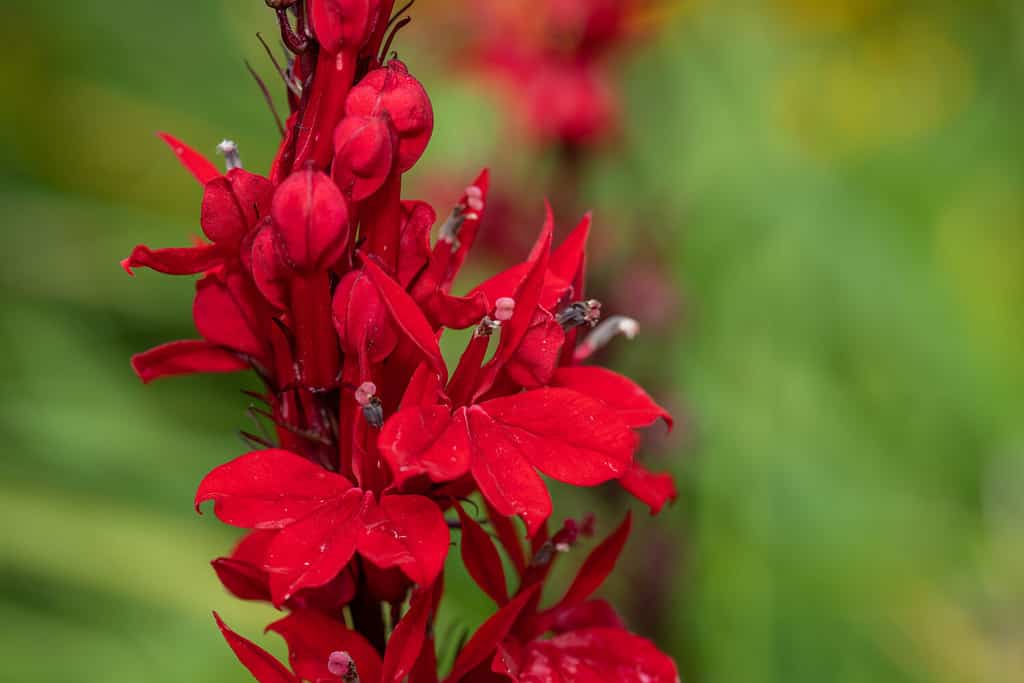
Another colorful fall-blooming flower in North Carolina is the cardinal.
©Tom Meaker/Shutterstock.com
A perfect choice for brightening up gardens in the fall, the cardinal flower is a favored perennial that grows upright and forms clumps. This plant boasts numerous flower stalks densely filled with vivid, cardinal red, dual-lipped flowers. These flowers measure about 2 inches in length, blooming from the latter part of summer to the middle of fall.
Sprouting from upright stems adorned with alternating leaves, this tall plant towers above a clump of lance-shaped, green leaves. Not only is it exceptionally hardy and easy to look after, but it is also mostly free from pests and diseases. Despite its tendency to have a shorter lifespan, it might naturally propagate in favorable environments without spreading aggressively.
This award-winning plant, honored with the Award of Garden Merit from the Royal Horticultural Society, can grow to heights of 2 to 4 feet and span a width of 1 to 2 feet.
Growing Tips
- Ideally planted in nutrient-rich, moderately damp to wet soils, under full sunlight or partial shade.
- Can thrive even when planted in water up to 3 inches deep.
9. Indian Blanket (Gaillardia pulchella)
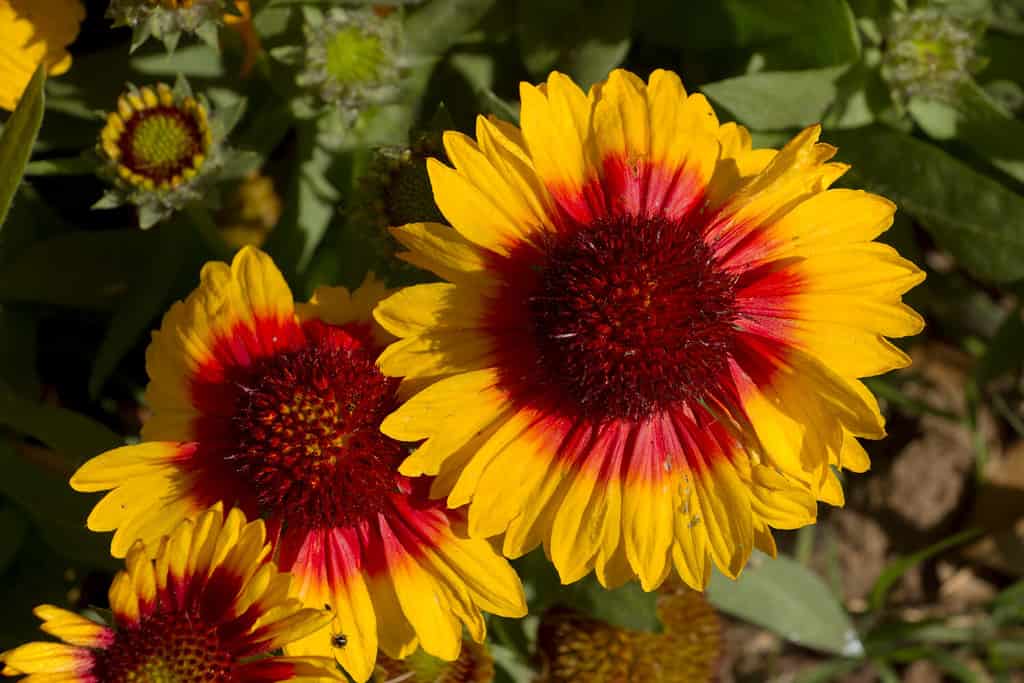
One of the most colorful fall-blooming flowers in North Carolina is the Indian blanket.
©Nick Greaves/Shutterstock.com
Native to many regions of the United States, the Indian blanket is a remarkable annual or sometimes a brief-lived perennial plant that showcases striking daisy-like blooms. Each of these flowers measures around 2 inches in diameter. These blooms feature a rich brownish-red core encircled by red petals with yellow edges.
These nectar-rich blossoms are a magnet for a variety of pollinators, including both honeybees and native bee species, as well as butterflies. Additionally, the seeds produced by these flowers are a favorite among birds. This flowering plant possesses the ability to naturally reseed, potentially establishing thick groupings of flowers.
This plant reaches a modest height of 10 to 12 inches and spans a width of 6 to 12 inches.
Growing Tips
- Best cultivated under full sunlight in soil conditions ranging from dry to medium moisture levels, with good drainage.
- Demonstrates a tolerance to saline conditions, making it a popular choice for landscapes situated near coastal areas.
10. Late Boneset (Eupatorium serotinum)

A perennial, the late boneset blooms in the fall.
©gala adi/Shutterstock.com
The late boneset is a perennial plant featuring upright stems with opposite pairs of lance-shaped leaves. When the early or late fall season arrives, the plant showcases large, flat clusters brimming with 12 to 15 tiny, white, rayless flowers at the stem tips. Lasting around a month, the blossoms attract various insects, including bees, butterflies, and moths.
Adding a distinctive flair to gardens, especially during the late season when flowering options might be scarce, the late boneset is a prime choice for native plant gardens. Its dramatic appearance is further amplified when planted in expansive sweeps in naturalistic gardens.
This plant typically reaches a height between 3 and 6 feet, though its actual size can vary greatly depending on moisture levels.
Growing Tips
- Thrives in areas receiving full sun to partial shade.
- Prefers fertile, humus-rich soil that is moist yet offers good drainage.
11. Creeping Burhead (Echinodorus cordifolius)
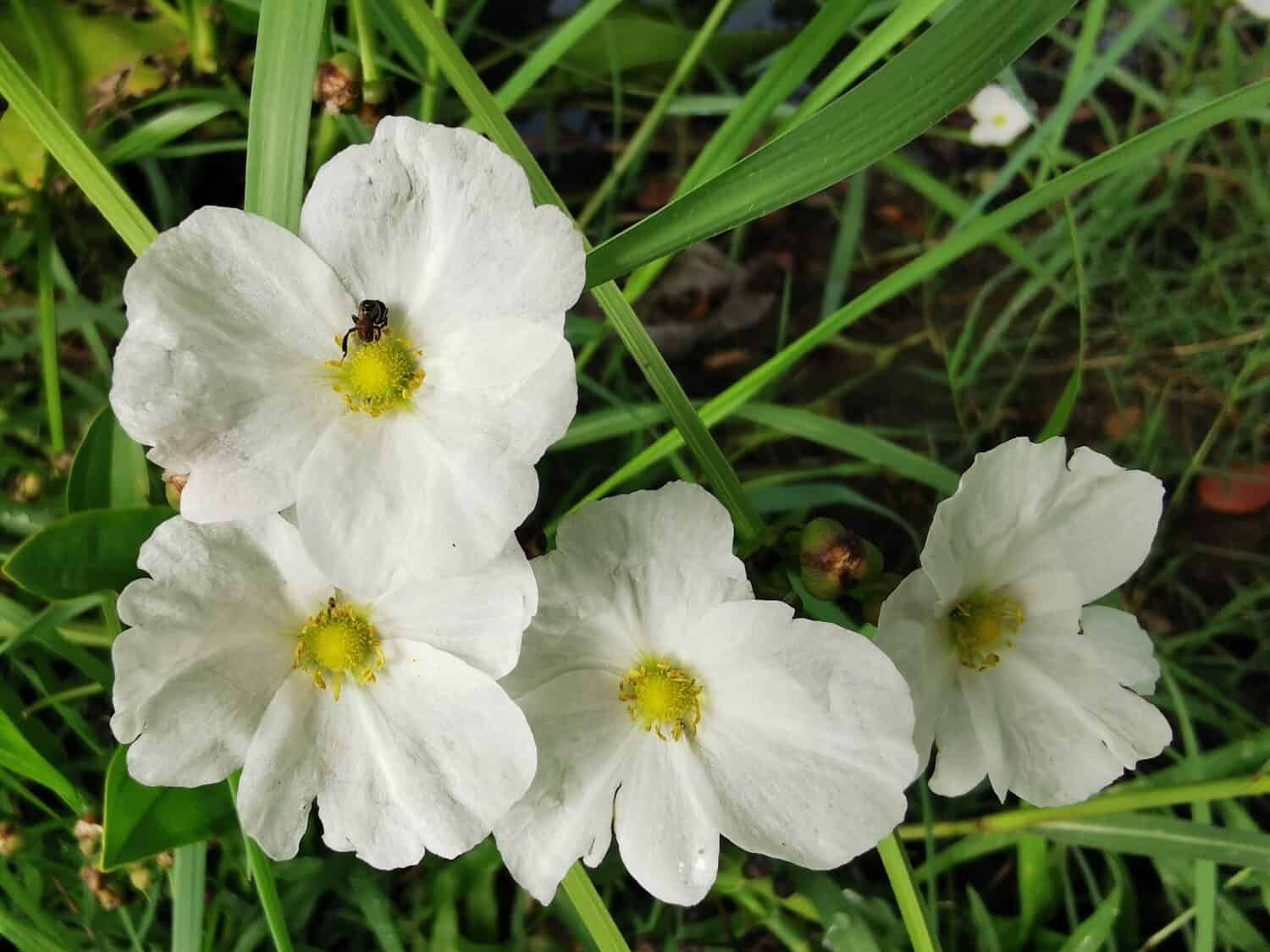
A perennial that thrives in aquatic environments, the creeping burhead blooms from spring to fall.
©mammoote/Shutterstock.com
The creeping burhead is a perennial plant that thrives in aquatic or damp environments. This plant exhibits large, heart-shaped, dark, glossy green leaves that can grow up to 16 inches long. The creeping burhead graces outdoor spaces with its prolific blooming from spring through fall, showcasing white flowers about an inch in diameter.
These blooms, organized in groups ranging from 3 to 15, adorn long stems that either arch or sprawl over the water’s surface, with a single stem capable of holding between 3 and 9 flower clusters. Each delicate flower comprises three small greenish sepals, three expansive white petals, and a center featuring 20 tiny yellow stamens.
This plant generally reaches heights between 2 and 4 feet, with a spread of about 3 feet.
Growing Tips
- Flourishes in moist to wet soil conditions and can tolerate both sunny and partially shaded areas.
- Can be successfully cultivated in waters up to 6 inches deep.
12. Partridge Pea (Chamaecrista fasciculata)
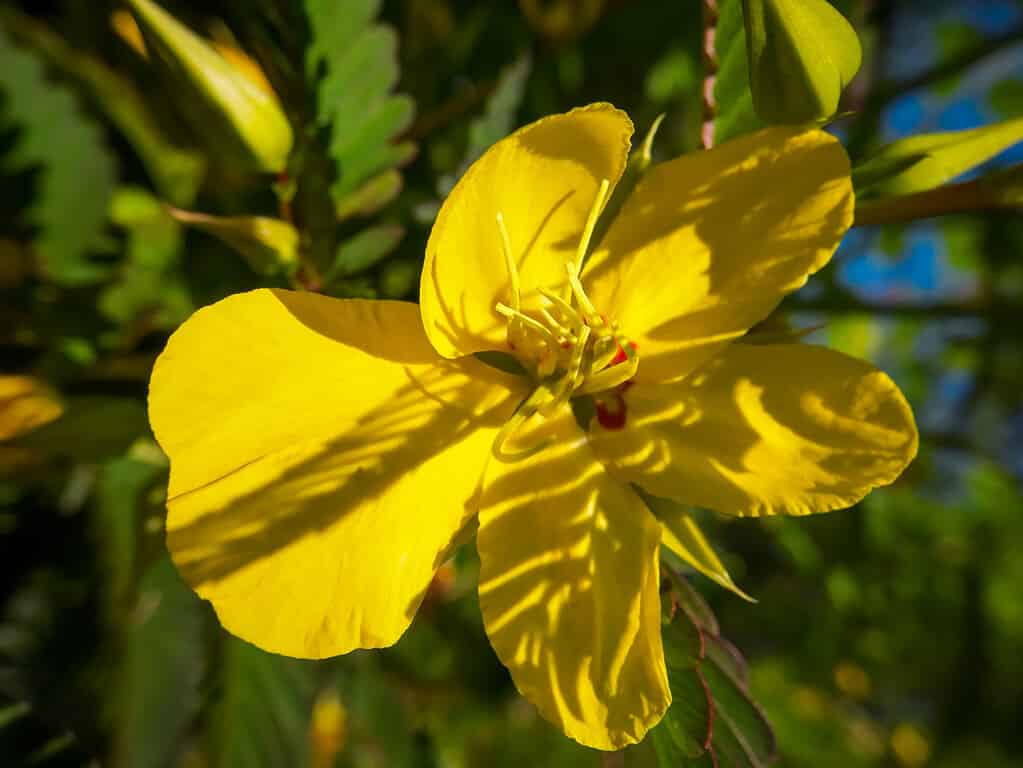
Boasting yellow blossoms, the partridge pea is attractive to bees and butterflies.
©DrWD40/iStock via Getty Images
The partridge pea graces gardens with its yellow blossoms grouped in clusters of two to four. These one-inch-wide flowers, adorned with standout red stamens, bloom profusely from early summer till the beginning of fall, offering a nectar-rich haven for bees and butterflies.
These bright blossoms give way to slender seed pods that burst open, dispersing seeds quite a distance away from the main plant. This process attracts various birds, including gamebirds and songbirds, who feast on the seeds. Moreover, the plant acts as a shelter for game birds. Planting partridge pea in native gardens or wildflower areas can significantly enhance the aesthetic appeal and atmosphere of these spaces.
This plant can grow between 1 and 3 feet in both height and spread. Note that it tends to propagate aggressively through self-seeding, especially in dry, open areas.
Growing Tips
- Ideally grown under full sun or light shade.
- Plant in soils that are moderately dry to medium-moisture and well-draining.
Summary of the Most Colorful Fall-Blooming Flowers in North Carolina
| Number | Flower | Blooming Period |
|---|---|---|
| 1. | Golden Crownbeared | Spring to fall |
| 2. | New York Ironweed | Mid-summer to mid-fall |
| 3. | American Blue Vervain | Early summer to fall |
| 4. | Hairy Aster | Late summer to fall |
| 5. | Nodding Lady’s Tresses | Late summer to late fall |
| 6. | Pitcher Sage | Mid-summer to frost |
| 7. | Shrubby Cinquefoil | Late spring to fall |
| 8. | Cardinal Flower | Late summer to mid-fall |
| 9. | Indian Blanket | Late spring to fall |
| 10. | Late Boneset | Early to late fall |
| 11. | Creeping Burhead | Summer to fall |
| 12. | Partridge Pea | Early summer to early fall |
The photo featured at the top of this post is © Gabriela Beres/Shutterstock.com
Thank you for reading! Have some feedback for us? Contact the AZ Animals editorial team.







